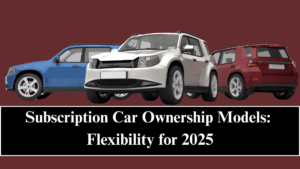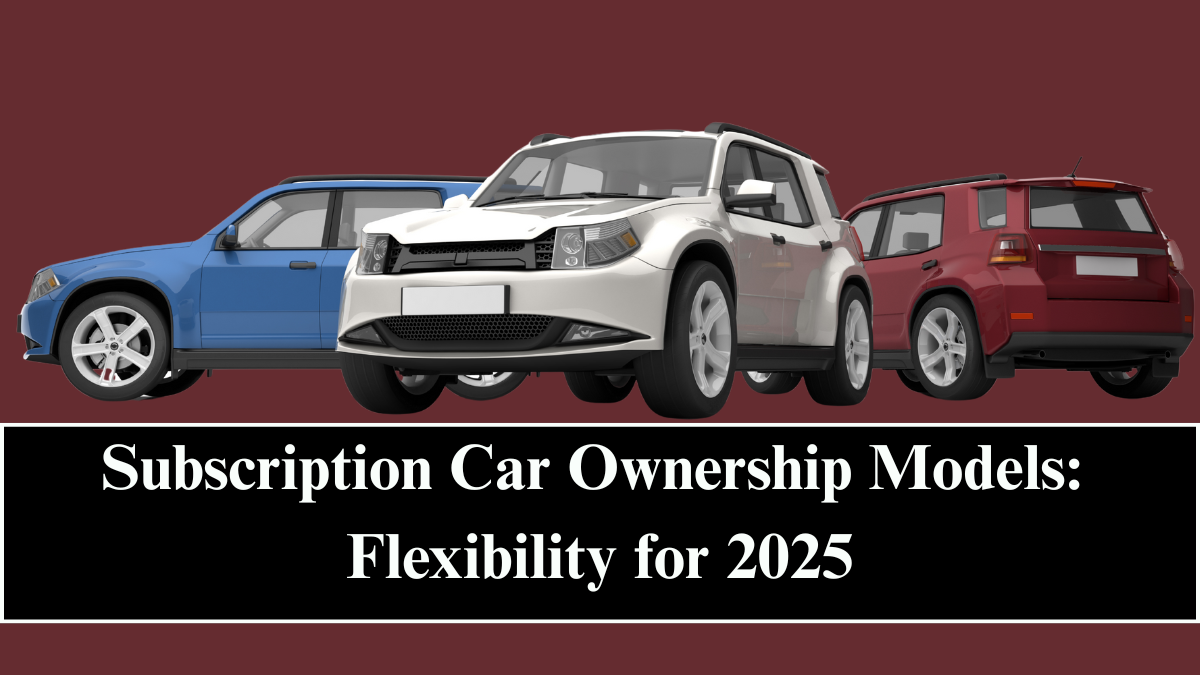In 2025, the automotive industry is witnessing a radical transformation in how people access vehicles. Traditional ownership—buying, insuring, and maintaining a car—is being replaced by subscription car ownership models, which offer drivers unparalleled flexibility and freedom.
Known as “Car-as-a-Service (CaaS)”, this model allows users to subscribe to a car for a monthly fee that covers everything—insurance, maintenance, taxes, and sometimes even roadside assistance. As lifestyles evolve and urban mobility becomes more dynamic, subscription-based ownership is emerging as the preferred alternative to conventional car buying.

The Shift from Ownership to Access
The modern consumer values access over possession, and this philosophy is redefining transportation. Just as streaming services revolutionized media consumption, subscription models are now doing the same for cars.
In 2025, subscription car ownership appeals to:
-
Urban professionals who prefer not to commit to long-term loans.
-
Frequent travelers needing short-term access across cities.
-
Younger drivers who prioritize flexibility over full ownership.
-
Businesses and startups managing small fleet requirements.
This shift signals a new era of mobility freedom, where convenience, cost transparency, and customization take precedence over traditional ownership hassles.
How Subscription Car Ownership Works
A car subscription service works much like a lease—but with greater flexibility and zero long-term contracts. Users simply sign up, pick a car, and pay a monthly fee.
A typical subscription package includes:
-
Comprehensive insurance coverage
-
Maintenance and servicing
-
Roadside assistance
-
Tax and registration fees
-
Option to switch vehicles anytime
Leading platforms in 2025 such as Care by Volvo, Hyundai Subscription, Maruti Suzuki Subscribe, and ONTO (UK) are offering flexible terms—from weekly rentals to annual plans—with just a few clicks through mobile apps.
The Rise of Car-as-a-Service (CaaS) Platforms
As part of the broader Mobility-as-a-Service (MaaS) ecosystem, CaaS platforms are blending digital innovation and customer convenience. In 2025, these services have matured into comprehensive ecosystems combining vehicle access, data analytics, and smart mobility integration.
Top global CaaS models include:
-
Volvo’s Care Program: All-inclusive packages with vehicle swaps every 12 months.
-
Hyundai Mobility Subscription: Customizable plans with electric and hybrid options.
-
Maruti Suzuki Subscribe (India): Affordable urban subscription plans for short-term users.
-
BMW Access and Porsche Drive: Targeting luxury customers with premium car rotation plans.
-
Zipcar and ONTO: Focused on electric mobility and sustainable short-term rentals.
These platforms leverage AI and data insights to predict demand, optimize fleet distribution, and offer tailored subscription options based on driving habits and preferences.
Benefits of Subscription Car Ownership
The growing popularity of subscription models is driven by their convenience and adaptability.
Key benefits include:
-
Flexibility: Choose, swap, or cancel anytime without heavy penalties.
-
All-inclusive pricing: No hidden costs—everything from maintenance to insurance is included.
-
Access to variety: Subscribers can switch between SUVs, sedans, or EVs based on needs.
-
Lower financial burden: Avoid down payments, EMIs, and long-term commitments.
-
Sustainability: Encourages shared use and fleet optimization, reducing carbon impact.
In an economy increasingly shaped by mobility-on-demand, this model aligns perfectly with how consumers value experience over ownership.
Integration with Electric Mobility
A notable trend in 2025 is the integration of electric vehicles (EVs) into subscription fleets. With governments promoting EV adoption through incentives, CaaS providers are expanding electric options to attract eco-conscious users.
EV subscription models offer:
-
Access to latest EVs without the fear of rapid tech obsolescence.
-
Free or discounted public charging access.
-
Lower maintenance costs compared to combustion vehicles.
-
Flexible range options, catering to city or highway needs.
This combination of subscription and electrification is reshaping urban mobility into a more sustainable, accessible, and data-driven experience.
Market Growth and Consumer Trends
The subscription-based car market in 2025 is projected to exceed $35 billion globally, with annual growth of over 25%. This boom is fueled by changing consumer behavior and technological innovation.
Trends shaping the sector include:
-
Digital-first onboarding: Users subscribe entirely online through apps or portals.
-
AI-based personalization: Services recommend cars based on usage patterns.
-
In-app management: Subscribers monitor mileage, payments, and maintenance via dashboards.
-
Integration with smart city platforms: Coordinating with public transport and ride-sharing networks.
This data-driven evolution ensures that car subscriptions remain not just flexible, but intelligently optimized for each driver.
Challenges in Subscription Adoption
While the model is growing rapidly, it still faces key hurdles in scaling globally:
-
High fleet acquisition costs for service providers.
-
Varying insurance laws across countries.
-
Limited resale markets for used subscription cars.
-
Consumer trust and habit change, especially among traditional buyers.
However, continued investment and partnerships between automakers, insurers, and fintech firms are helping overcome these challenges by making the process simpler, transparent, and cost-effective.
The Future of Car Ownership
By 2030, industry experts predict that subscription models could replace 20–25% of traditional car purchases, especially in urban centers. The future will likely see:
-
AI-managed subscription ecosystems that predict user needs.
-
Integration with autonomous ride-hailing fleets.
-
Dynamic pricing based on driving behavior and time of use.
-
Sustainable fleet management, using circular economy principles for vehicle reuse.
In essence, car subscriptions will bridge the gap between personal freedom and shared responsibility, creating a hybrid ownership culture fit for modern lifestyles.
FAQs
What is a car subscription model?
It’s a flexible mobility plan where users pay a monthly fee for car usage, covering insurance, maintenance, and taxes—without owning the vehicle.
How is it different from leasing?
Unlike leasing, subscriptions offer short-term, cancellable plans and the ability to switch vehicles anytime.
Are electric cars available on subscription?
Yes, most 2025 programs include EVs and hybrids with access to nationwide charging networks.
What’s the average cost of a car subscription in 2025?
Depending on the car type and region, prices range from $400 to $1,200 per month for all-inclusive plans.
Will subscriptions replace car ownership entirely?
Not entirely, but they will become a mainstream alternative, especially in cities where flexibility and sustainability drive demand.
Click here to know more.
